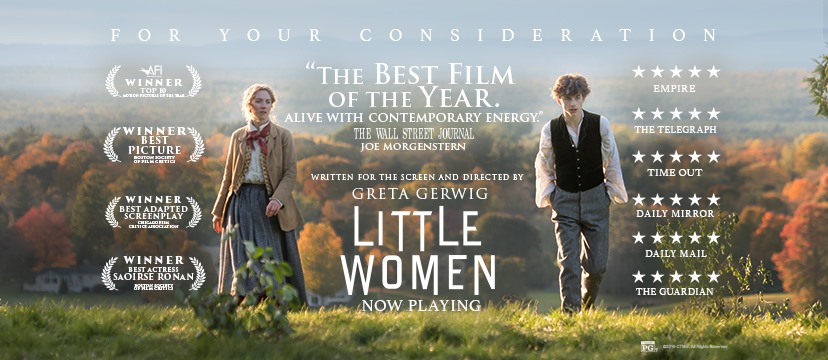Warning: this review contains spoilers for the film “Little Women.”
In 2019, Greta Gerwig took on the challenge of recreating the story of “Little Women” – a story that had been retold a plethora of times with several movie adaptations. Gerwig had to add a new dimension and appeal to the film while still preserving the vision of Louisa May Alcott, the author of the original story, along with the timeless themes that the original story expresses. After watching the film, Gerwig succeeds with this arduous task in many ways. Gerwig’s rendition offers something to all viewers, regardless of the extent of their familiarity with the original story.
The newest adaptation of “Little Women,” like all previous adaptations and the original novel by Louisa May Alcott, poignantly tells the story of four sisters — Meg, Jo, Beth and Amy — growing up in the unique period time period both during and after the Civil War. Despite the novel’s 1868 publication, it is a story with themes that are still applicable to women today. The sisters are not without their flaws, they feud with one another and they seek revenge on each other in ways that are irreversible. Together they learn the sometimes-painful realities of life and discover their own character, shortcomings and potentials.
Gerwig’s adaptation further exemplifies the essence of “Little Women” — love in all its forms. Although romantic love is portrayed in a sublime way throughout the story, Gerwig never intended for that to be the sole focus of the film. The unique beauty of “Little Women” lies in its portrayal of the love that is shared between both sisters and between mothers and their daughters. There is also the love that the girls have for their passions and dreams, whether it be with Amy and her paintings, Beth and her piano or Jo and her writing; the girls all had undaunting ambition that could not be contained by their setting or time.
Gerwig’s creates a twist on the story by implementing a non-linear timeline, which allows her to demonstrate the stark contrast between childhood and adulthood. The former portrayed to be full of warmth and light and the latter full of greys and gloom, demonstrated by the different color grading on the scenes from each respective period. This contrast demonstrates Jo’s shifting perspective on life. Although Jo sees adulthood as lacking vivacity and constantly strives to preserve her childhood, Meg is happy to be settling down with her husband John, welcoming adulthood with ease and acceptance. Jo pleads with Meg to run away with her before her wedding takes place, but Meg insists she is happy with the path she chose toward adulthood. As the film progresses, Jo comes to more openly accept the realities of growing old. Yet, her longing for her lost childhood never fully ceases.
Arguably, the most important element of the story that Gerwig does differently in her adaptation is the ending, which further strengthens the sentiments expressed throughout the film. As Jo is finally about to get her own novel, also titled “Little Women,” published, the editor insists that the main character, who represents Jo herself, has a romantic interest at the end of the novel. Jo at first resists, but eventually compromises in order to keep the copyright for her characters. The screen then cuts to Jo chasing after Professor Bhaer and confessing her love. In the book, the couple gets married but the film leaves this plot point up to interpretation. This multilayered ending acknowledges that Alcott may have originally sacrificed the ending she wanted to please an audience and increase her chances of getting published by writing an ending that adheres more to the typical genre clichés of the time.
Due to Gerwig’s change, Jo is able to get married without having to sacrifice her independent spirit and goals or without caving into the societal pressure to be married. It would have created a different narrative had she ended up marrying her childhood friend and admirer Laurie, a decision she would have made simply to alleviate her loneliness and fulfill the expectation of marriage. In this way, Gerwig honors Alcott’s original vision while simultaneously celebrating love through Jo and Bhaer’s marriage.
Jo and her marriage to Professor Bhaer, however, is not the sole focus of the ending. Instead, it is focused on the binding and publishing of Jo’s novel along with the opening of her school, through which she is able to preserve the enchanting spirit of childhood she had always longed for by teaching a new generation; it is her love for her career as a writer and teacher that truly makes her happy. The ending is a happy one. In the end, love, in all its forms, is triumphant.
Gerwig reverberates the same message that Alcott had first conveyed, that humans, particularly women, can be truly extraordinary when they love.
Saliha Bayrak can be reached at [email protected].




















